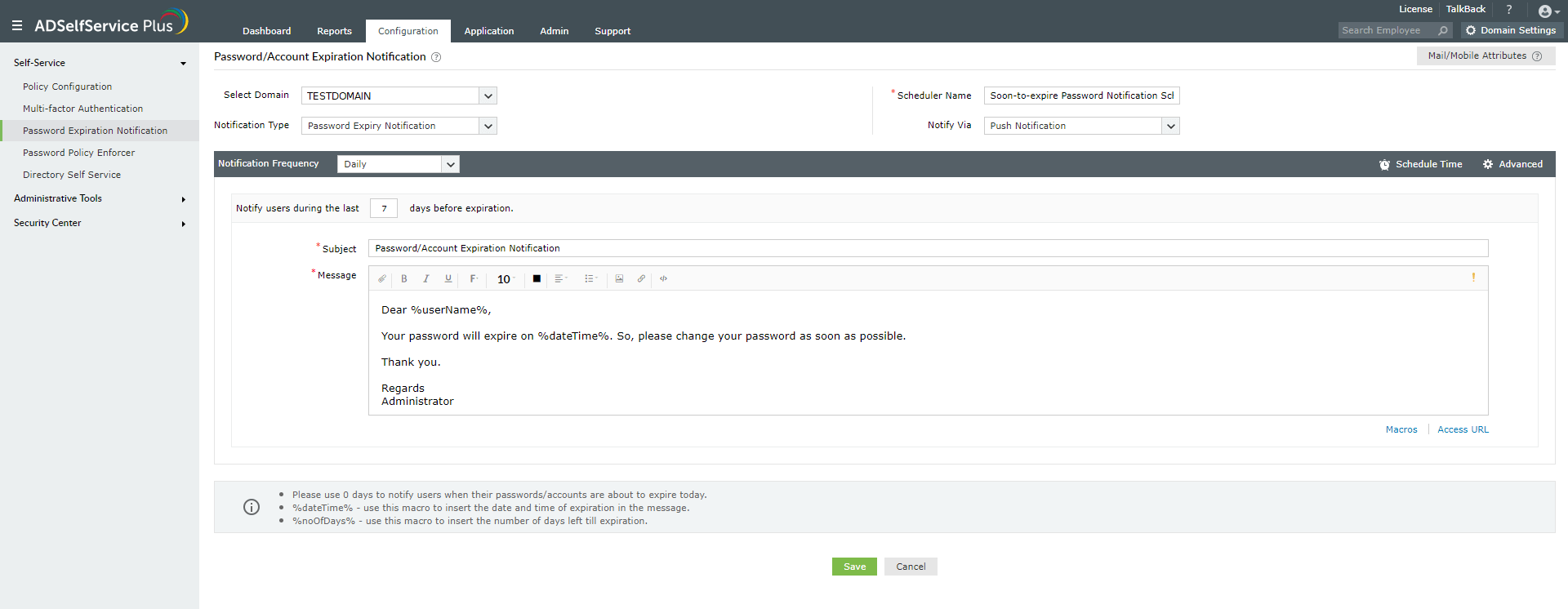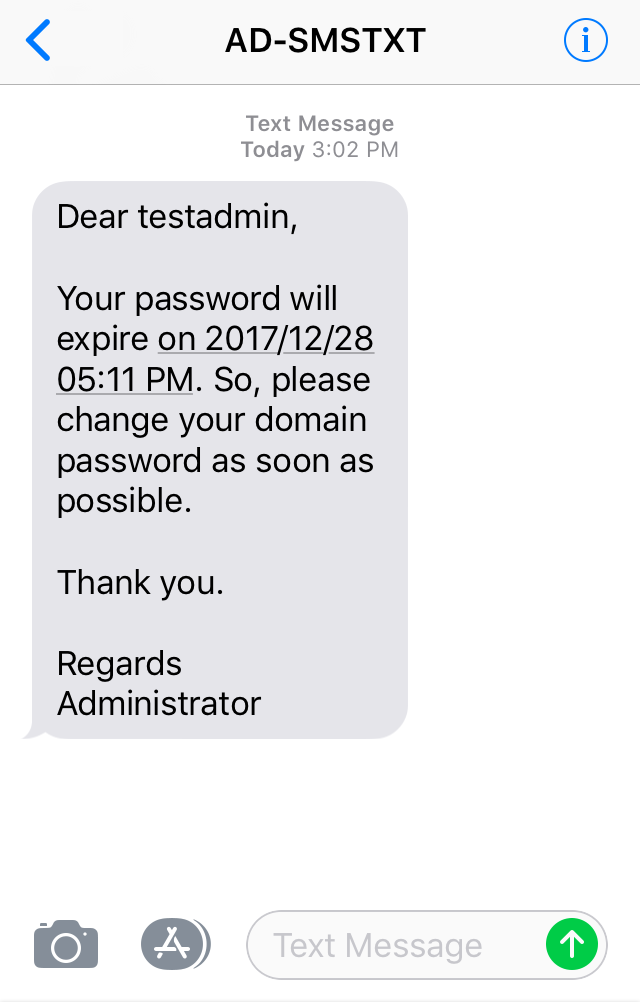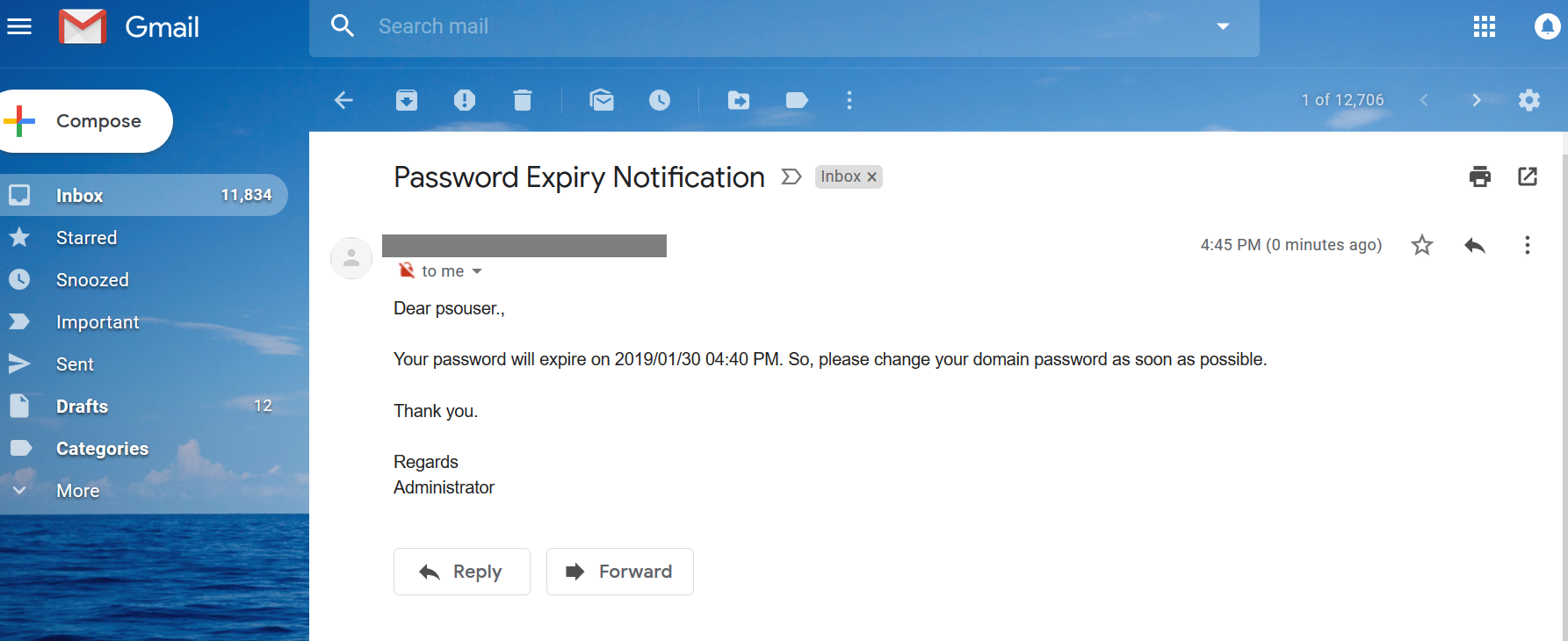- Free Edition
- Quick Links
- MFA
- Self-Service Password Management
- Single Sign-On
- Password Synchronizer
- Password Policy Enforcer
- Employee Self-Service
- Reporting and auditing
- Integrations
- Related Products
- ADManager Plus Active Directory Management & Reporting
- ADAudit Plus Real-time Active Directory Auditing and UBA
- Exchange Reporter Plus Exchange Server Auditing & Reporting
- EventLog Analyzer Real-time Log Analysis & Reporting
- M365 Manager Plus Microsoft 365 Management & Reporting Tool
- DataSecurity Plus File server auditing & data discovery
- RecoveryManager Plus Enterprise backup and recovery tool
- SharePoint Manager Plus SharePoint Reporting and Auditing
- AD360 Integrated Identity & Access Management
- Log360 (On-Premise | Cloud) Comprehensive SIEM and UEBA
- AD Free Tools Active Directory FREE Tools
Free tool to proactively send Windows password expiration notifications via email, SMS, and push
Password-related disruptions are one of the most common productivity bottlenecks in any organization. While Microsoft changed its guidelines on password expiration by no longer recommending it, many organizations continue to maintain a password expiration policy as a precautionary measure aimed at minimizing long-term security risks. End-users continue to find themselves locked out of their machines, having overlooked the Windows pop-up expiry alerts or not receiving them at all during remote connections.
A key feature of ADSelfService Plus is the Active Directory password expiration notification. It helps users stay ahead of password expiry by sending timely reminders via email, SMS, and push alerts.
This password and account expiration notification tool automatically assesses Active Directory for accounts nearing password expiry and sends personalized password expiration notification emails to the respective users. This tool is 100% free with no restrictions.
Why you need push, SMS, and email password expiration notifications for Active Directory
Active Directory doesn't natively send password expiration notifications via email, SMS, or push alerts, especially for remote users on VPN or Outlook Web Access (OWA). This often leaves employees stranded and dependent on the help desk once their passwords expire. Here is a comparison between Windows password expiration notifications and ADSelfService Plus' password expiration notifier:
| Features | Windows password expiration notifier | ADSelfService Plus password expiration notifier |
|---|---|---|
| Remind users about expiring passwords and accounts | ✓ | ✓ |
| Send multiple notifications at regular intervals | ✓ | ✓ |
| Customizable email and SMS messages | X | ✓ |
| OU- and group-based policies | X | ✓ |
| Schedule and export reports | X | ✓ |
| Multiple delivery methods | Push notifications | Email, SMS, and push notifications |
With ADSelfService Plus’ Active Directory password expiration notifier tool, you can bridge this gap effortlessly. Ensure users receive multiple reminders with ample time to securely change or reset their passwords before they expire. ADSelfService Plus also notified users when their account expires in Active Directory.
Key features of the AD password expiration notification tool
Granularly-targeted password expiration notifications
ADSelfService Plus enables you to create tailored notification policies based on domains, organizational units (OUs), and user groups. This lets you set different password and account expiration notification policies for various teams or ranks within the organization. For example, IT admins and managers can receive less frequent but more urgent notifications, while general users can get a gradual and consistent alert sequence.
Phased password expiration alerts
Instead of overwhelming users with a single reminder close to password expiry, phased notifications ensure that reminders are sent out at multiple intervals—such as 14 days, 7 days, 3 days, and 1 day before expiration. This progressive approach improves user awareness and gives them ample time to update their passwords, thereby reducing the risk of account lockouts and help desk calls. By spacing out alerts, organizations can promote proactive password management and encourage better user compliance. Each notification can be fine-tuned to reflect urgency as the expiration date nears—ensuring your users are not only informed, but motivated to take action.
Customizable Active Directory password expiration notification
ADSelfService Plus offers rich customization options for password and account expiration notifications, enabling IT teams to create professional, branded messages that improve user engagement. You can design messages using HTML for enhanced formatting, incorporate company logos or custom images, and attach relevant files such as password policy documents or security guidelines. Dynamic macros allow you to auto-populate user-specific details like name, username, domain, and password expiry date, ensuring each message is personalized and context-aware.



Real-world scenario: The cost of not using a password expiration warning system
Imagine having an enterprise with 1,000 employees, including 200 remote users. Without Windows password expiration notification, users may miss expiration alerts entirely, leading to account lockouts and help desk calls. Even with a self-service password reset solution, the absence of proactive alerts means your IT support team is still fielding dozens—or even hundreds—of avoidable tickets.
Now contrast that with a robust SMS and email password expiration notification system. Users get timely reminders, reset their passwords independently, and the help desk enjoys a massive reduction in password-related tickets.
Why choose ADSelfService Plus as your Active Directory password expiration notifier?
Use it for free: Send Active Directory password expiration notification emails to all users in your organization at no cost.
OU and group-based targeting: Create tailored notification policies based on domains, OUs, and user groups.
Customizable reminder templates: Edit the design and tone of password expiration notification emails using HTML templates and attachments.
Phased notifications: Configure a series of escalating reminders—e.g., 15, 10, 7, 3, and 1 day(s) before password expiry—for maximum effectiveness.
Manager alerts: Notify reporting managers about upcoming password or account expirations of their team members.
Account expiry reminders: Extend notifications beyond passwords by alerting users when their Active Directory account expires.
Comprehensive reporting: Track delivery status and view detailed logs of all password expiration alerts.
Highlights of ADSelfService Plus
Password self-service
Unburden Windows AD users from lengthy help desk calls by empowering them with self-service password reset and account unlock capabilities.
Multi-factor authentication
Enable context-based MFA with 20 different authentication factors for endpoint, application, VPN, OWA, and RDP logins.
One identity with single sign-on
Get seamless one-click access to more than 100 cloud applications. With enterprise single sign-on (SSO), users can access all their cloud applications using their Windows AD credentials.
Password and account expiry notifications
Notify Windows AD users of their impending password and account expiry via email and SMS notifications.
Password synchronization
Synchronize Windows AD user passwords and account changes across multiple systems automatically, including Microsoft 365, Google Workspace, IBM iSeries, and more.
Password policy enforcer
Strong passwords resist various hacking threats. Enforce Windows AD users to adhere to compliant passwords by displaying password complexity requirements.
FAQs
Password expiry notifications are reminders sent to users as text messages, emails, or push notifications when their Active Directory password is about to expire. These reminders urge users to change the password before it expires so they don't get locked out of their Active Directory accounts.
Without a password expiration reminder, users will not know about their AD password's expiry date. Expired passwords lock users out of their accounts, freezing their productivity until the password is reset. Password expiry notifications alert users to change their passwords before they expire to avoid such hassles.
However, it is necessary to send multiple reminders to users about their upcoming password expiration to ensure that they do not miss changing their password.
You can employ ADSelfService Plus' password expiration notification capability in your organization to remind users about password expiry. ADSelfService Plus allows you to send customizable password expiry notifications via email and SMS.
Check out this detailed walkthrough on how you can set up MFA for Outlook on the web in your organization using ADSelfService Plus. You can also schedule a personalized web demo with our product experts, or get in touch with our sales team at +1.312.528.3085 or sales@manageengine.com for any further assistance.
Yes, ADSelfService Plus allows you to customize the content of your password expiry notification emails and SMS messages as per your organization's communication style and requirements. You can scale the urgency of your password expiration messages as the expiry date draws near, with the help of the templates available in ADSelfService Plus.
ADSelfService Plus also lets you set up group-based and OU-based password expiration notification policies in your organization. With these, you can configure separate policies for employees of higher ranks, if necessary. Most importantly, ADSelfService Plus allows you to schedule and send multiple password expiry reminders to users, because it is highly unlikely that users will change their passwords immediately after a single password expiry email or SMS notification.
Yes, ADSelfService Plus allows you to send customized AD account expiry notifications to your users, similar to password expiry notifications. You can also choose to notify the respective managers about their employees' account expiration status, if needed.










